Nature Communications publishes Ramachandran article
By Colbi Edmonds
Professor Siddharth Ramachandran (ECE, MSE, Physics), ECE student Aaron Greenberg and former PhD student Gautam Prabhakar co-authored an article in Nature Communications. In High resolution spectral metrology leveraging topologically enhanced optical activity in fibers, Ramachandran and his team describe a study of the interaction of light with chiral materials, which leads to a phenomenon called optical activity, where light’s orientation (polarization) rotates on its own as it travels.

A chiral structure is not superimposable on its mirror image, just as the mirror reflection of the right hand produces an image, not of itself, but of the left hand. Several organic compounds — glucose, DNA and other building blocks of living organisms — possess this same structural property, and the pharmaceutical industry regularly uses optical activity to determine chemical compositions.
However, optical activity is not found in common optics and photonic materials such as glass and semiconductors. But, Ramachandran’s group has found a way to mimic and control optical activity by using light-carrying orbital angular momentum (OAM) to interact with regular, isotropic, non-chiral materials, such as ordinary glass, in optical fibers. Hence, optical activity is no longer a property of the material alone, but can be designed and engineered for applications.

The group’s work has been applied to spectrometers, which have a common tradeoff: they are either high resolution and slow, or fast with low-resolution. The cumulative effect of optical activity can now be scaled by several orders of magnitude in comparison to natural chiral materials because optical fibers naturally yield long interaction lengths. The enhanced effect of optical activity, along with light’s dispersive properties, can be used to construct a spectrometer that has the capability to measure a wavelength of light — in a single-shot measurement and hence at rates as high as GHz — down to 0.3 pm precision.

High-speed precision monitoring is of importance to many fields such as environmental monitoring, homeland security threat detection, and the study of dynamical biological processes.
This work comes as another application utilizing the novel effects of light beams carrying OAM, a field being extensively researched by the Ramachandran group, who have published their findings in several prominent journals such as Optica, Science and Physical Review Letters. Ramachandran was recently named a 2019 Vannevar Bush Faculty Fellow and is a Fellow of IEEE, OSA and SPIE.